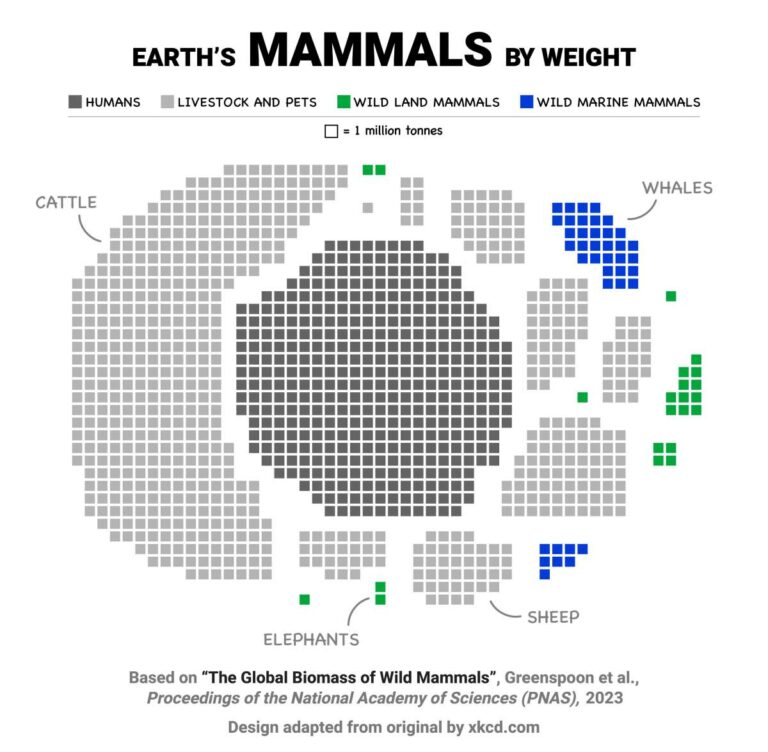
‘발전과 성장’ 에서 공생으로
공존의 길 찾지 않으면 공멸 뿐
지난주엔 토론토대학 박사과정에 있는 한 젊은 한인 청년을 만났다. 환경문제에도 아주 관심이 많은 그는 환경사를 공부하기도 했다고 말했다. 환경문제에 대한 역사라니, 아주 흥미로웠다. 아쉽게도 짧은 대화였지만 아주 오래 전부터 인류가 환경을 어떻게 대하고 살아왔는지에 대한 고찰부터 현재와 미래까지 아우르는 과목이라고 했다. 그의 여러 이야기 중 한가지가 기억에 남았다. “과거에는 인간이 자연을 적으로 여겨왔으나 이제는 자연이 인간을 적으로 여기게 됐다”는 말이다.
과학 문명이 발달하기 전 인간은 자연으로부터 끊임없는 위협을 받아왔다. 호모 사피엔스가 살아온 지난 30만년 동안 홍수 가뭄 추위 같은 재해 뿐 아니라 미생물들이 옮기는 질병은 더욱 큰 어려움이었다. 맹수는 물론 먹이다툼을 벌여온 동종의 영장류와 작은 모기까지 인류에게 위험이 되지 않은 것은 거의 없었다. 그러다 보니 호모 사피엔스는 거의 30만년 개체수 증가가 매우 더뎠다. 1만년 전에 이르러서야 가축을 포함해 육상 전체 포유동물의 겨우 1%를 차지했다. 어릴 때부터 사망 확률이 지금과 비교할 수 없을 만큼 높았다.
그러나 지난 몇 백 년 간 인류는 엄청난 속도로 과학을 발전시켜오며 그 위험들을 제거해 왔다. 날씨를 예측해 미리 재해를 피하거나 줄일 수 있고 맹수는 동물원이나 특정지역에 가두다시피 했다. 대부분의 병도 어느정도 제어가 됐고 농업 생산성도 도약을 거듭해 버려지는 식량만 활용하더라도 전 세계 인구가 배를 곪지 않을 수 있다. 1만년 전 1%이던 인류와 그 가축이 육지에 사는 전체 포유동물의 98%가 넘게 됐다. 사람만 따지면 39%나 된다. 지구 역사상 이런 급변은 없었다. 단 하나의 종이 이처럼 지구 전체를 뒤덮다니. 태초 원시 생명체가 바다를 채우고 이어 육지를 채운 이후 처음일 것이다. 그 절정은 산업혁명 이후다. 본격적으로 석탄을 태워 산업을 일으키며 현재의 안정적인 삶을 만든 것은 채 100년이 지나지 않았고 인구 증가는 하키스틱처럼 우상향으로 치솟았다.
그런데 왜 지금 우리는 자연의 역습을 걱정하며 미래를 불안하게 내다보고 있을까? 바로 이런 인류의 문명이 지구의 자원을 이용해 이룩한 것이기 때문이다. 자원은 지극히 한정돼 있고 지구의 순환계는 나름대로 회복 탄력성이 좋지만 지구 전체를 뒤덮은 인류는 이제 그 회복탄력성을 무너트릴 만큼 영향력을 키웠다. 볼펜 속 스프링을 빼 내어 조금 당기면 제자리로 돌아가지만 더 많이 당기다 보면 어느 순간 쭉 늘어나 다시 원래대로 돌아가지 않는다. 회복 탄력성을 상실한 것이다. 인류가 지금 지구에 가하는 스트레스가 바로 이 지점을 지나기 직전이라는 것이 과학자들의 설명이도 어느 부분은 이미 그 탄력성을 잃어 버린 것이란 판정이 나오기 시작했다.
이제 지난 몇 백년간 인류가 이뤄온 ‘발전’과 ‘성장’, 무한한 것으로 여긴 ‘자원’을 통한 경제와 문명 시스템이 앞으로도 지속될 수 없음을 알게 됐다. 자연을 무시하고 일궈낸 문명은 백여 년 동안 그럴 듯 해 보였지만 그 한계가 드러났다. 인류가 사용하는 모든 문명은 그 근원이 자연에서 온 것이다. 지금 사용하는 컴퓨터는 실리콘, 플라스틱, 유리 등 모두 자연에서 기원한 것이고 입고 있는 옷과 먹는 음식, 자동차 등 그 어느 하나 자연에서 오지 않은 것이 없다. 지금처럼 인류가 자연이 주는 자원을 가져온다면 지구 2개가 있어야 한다. 지금은 자녀들이 사용할 자원을 미리 가져다 쓰고 있다. 후손들은 우리가 보는 아름다운 산호초도, 다양한 생명종도, 평화로운 들판도 못보게 될 수 있다.
최근 413 고속도로 건설을 반대하는 글에 대해 어떤 분이 “예전 경부고속도로 건설도 반대하는 인간도 있었고 집을 짓지 않으면 어디서 살라는 말인가” 라고 물었다. 50년 전에는 경부고속도로 건설이 옳았다 해도 이제는 다른 셈법을 찾아야 한다. 그대로는 공멸 뿐이다. 인류는 이제 아직 가보지 않은 길을 찾아야 한다. 지난 1백년 동안 처럼 잘 먹고 잘살겠다고 뿜어낸 이산화탄소와 자원 착취로 우리 자녀들과 손주들에게 지옥 같은 세상을 물려주지 않으려면.
We need to reorient ‘development and growth’
We need to find a way to coexist or we’re doomed
Last week, I met a young Korean-Canadian PhD candidate at the University of Toronto who is very interested in environmental issues, and he told me that he also studied environmental history. The history of environmental issues was very interesting. Unfortunately, our conversation was short, but he told me that the subject encompasses how humans have lived and treated the environment from a very long time ago to the present and the future. One of his stories stuck with me. “In the past, nature has been the enemy of human, but now human is the enemy of nature,” he said.
Before the development of scientific civilization, humans were under constant threat from nature. Over the past 300,000 years of Homo sapiens’ existence, we’ve faced disasters like floods, droughts, and cold, as well as diseases carried by microbes. There were few things that didn’t pose a danger to humans, from predators to fellow primates and tiny mosquitoes that we competed with for food. As a result, Homo sapiens’ population growth was very slow for nearly 300,000 years. By 10,000 years ago, we made up just 1% of all mammals on land, including livestock. The odds of dying at an early age were incomparably higher than they are today.
Over the past few hundred years, however, humans have made tremendous scientific advances and eliminated many of these risks: weather can be predicted to avoid or reduce disasters in advance, and wild animals are confined to zoos or specific areas. Most diseases are under control, and agricultural productivity has increased by leaps and bounds, so that the world’s population could be fed by utilizing only the food that is thrown away. From 1% 10,000 years ago, humans and their livestock now make up over 98% of all mammals on land. Humans alone account for 39%. Never in the history of the planet has there been such a rapid change. Never before has a single species covered the entire planet like this. This is probably the first time since primitive life filled the oceans and then the land. The culmination was the Industrial Revolution. It was only a hundred years before we started burning coal in earnest, creating the industries that have made our lives so stable, and population growth shot upward like a hockey stick.
So why are we now looking anxiously into the future, worried about nature striking back? It’s because our civilization was built on the resources of the Earth. Resources are finite, and the Earth’s cycles are resilient, but humanity’s presence on the planet has grown to the point where we’ve broken that resilience. If you take the spring out of a ballpoint pen and pull it a little, it will return to its original position, but if you pull it more, it will eventually stretch and not return to its original position. It has lost its resilience. Scientists are beginning to realize that the stresses we’re putting on the planet are on the verge of pushing it past this point, and that it has already lost some of its resilience.
We now know that the economic and civilizational systems of “development,” “growth,” and “resources” that humans have built over the past few hundred years, which we thought were limitless, are unsustainable. Civilizations built by ignoring nature have seemed plausible for hundreds of years, but their limits have been exposed. Every civilization we use has its roots in nature. The computers we use today are made of silicon, plastic, and glass, and the clothes we wear, the food we eat, and the cars we drive are all derived from nature. If humans were to take resources from nature as we do now, there would be two Earths. Right now, we are taking resources for our children’s use. Our children may not have the beautiful coral reefs, biodiversity, or peaceful fields that we see today.
In response to a recent article opposing the construction of the 413 highway, someone asked, “Some people opposed the construction of the Gyeongbu Expressway in Korea before, and said, “If you don’t build a house, where will you live? Even if the construction of the Gyeongbu Expressway was right 50 years ago, we need to find a different way of calculating. Or the only result is extinction. Humanity needs to find a path that hasn’t been traveled yet.
If we continue to emit carbon dioxide and exploit resources as we have done for the past century in the name of living well, we will bequeath a hellish world to our children and grandchildren.
